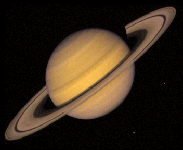Previously unseen belt of moonlets discovered in Saturn’s outermost ‘A’ ring
 Washington, Oct 25 : An international team of astronomers from the US, Germany and Finland have detected a previously unseen belt of moonlets in Saturn’s outermost ‘A’ ring.
Washington, Oct 25 : An international team of astronomers from the US, Germany and Finland have detected a previously unseen belt of moonlets in Saturn’s outermost ‘A’ ring.
Lead author, CU-Boulder Research Associate Miodrag Sremcevic said the bodies were probably the debris of a collision between a wayward asteroid or comet and a larger moon, eons ago.
He said the High Resolution Stereo Camera (HRSC) onboard the NASA/ESA/ASI Cassini spacecraft revealed a series of eight propeller-shaped “wakes” in a thin belt of the outermost “A” ring, indicating the presence of corresponding moonlets.
Each propeller feature was about 10 miles long and highlighted tiny areas of the belt where the ring material had been perturbed by the gravitational forces caused by individual moonlets, he said.
He said team calculated thousands of moonlets ranging in size from semi-trailers to sports arenas embedded in the “A” ring's thin moonlet belt that circled the planet.
At about 2,000 miles across, the belt of moonlets was only about 1/80th the diameter of Saturn's total ring system, which at roughly 155,000 miles across stretched about two-thirds of the way from Earth to the moon, he said.
Sremcevic said this was the first evidence of a moonlet belt in any of Saturn's rings.
“We have firmly established these moonlets exist in a relatively narrow region of the “A” ring, and the evidence indicates they are remnants of a larger moon that was shattered by a meteoroid or comet,” said Sremcevic.
Co-authors of the study include Juergen Schmidt, Martin Seiss and Frank Spahn of the University of Potsdam in Germany, Heikko Salo of the University of Oulu in Finland, and Nicole Albers of CU-Boulder's LASP.
The study appears in the Oct 25 issue of the journal Nature. (ANI)